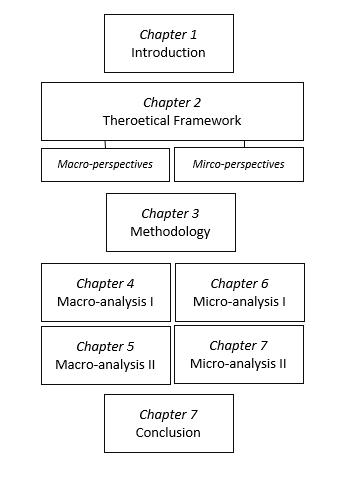How to write a fantastic thesis introduction (+15 examples)
The thesis introduction, usually chapter 1, is one of the most important chapters of a thesis. It sets the scene. It previews key arguments and findings. And it helps the reader to understand the structure of the thesis. In short, a lot is riding on this first chapter. With the following tips, you can write a powerful thesis introduction.
Disclosure: This post may contain affiliate links, which means I may earn a small commission if you make a purchase using the links below at no additional cost to you . I only recommend products or services that I truly believe can benefit my audience. As always, my opinions are my own.

Elements of a fantastic thesis introduction
Open with a (personal) story, begin with a problem, define a clear research gap, describe the scientific relevance of the thesis, describe the societal relevance of the thesis, write down the thesis’ core claim in 1-2 sentences, support your argument with sufficient evidence, consider possible objections, address the empirical research context, give a taste of the thesis’ empirical analysis, hint at the practical implications of the research, provide a reading guide, briefly summarise all chapters to come, design a figure illustrating the thesis structure.
An introductory chapter plays an integral part in every thesis. The first chapter has to include quite a lot of information to contextualise the research. At the same time, a good thesis introduction is not too long, but clear and to the point.
A powerful thesis introduction does the following:
- It captures the reader’s attention.
- It presents a clear research gap and emphasises the thesis’ relevance.
- It provides a compelling argument.
- It previews the research findings.
- It explains the structure of the thesis.
In addition, a powerful thesis introduction is well-written, logically structured, and free of grammar and spelling errors. Reputable thesis editors can elevate the quality of your introduction to the next level. If you are in search of a trustworthy thesis or dissertation editor who upholds high-quality standards and offers efficient turnaround times, I recommend the professional thesis and dissertation editing service provided by Editage .
This list can feel quite overwhelming. However, with some easy tips and tricks, you can accomplish all these goals in your thesis introduction. (And if you struggle with finding the right wording, have a look at academic key phrases for introductions .)
Ways to capture the reader’s attention
A powerful thesis introduction should spark the reader’s interest on the first pages. A reader should be enticed to continue reading! There are three common ways to capture the reader’s attention.
An established way to capture the reader’s attention in a thesis introduction is by starting with a story. Regardless of how abstract and ‘scientific’ the actual thesis content is, it can be useful to ease the reader into the topic with a short story.
This story can be, for instance, based on one of your study participants. It can also be a very personal account of one of your own experiences, which drew you to study the thesis topic in the first place.
Start by providing data or statistics
Data and statistics are another established way to immediately draw in your reader. Especially surprising or shocking numbers can highlight the importance of a thesis topic in the first few sentences!
So if your thesis topic lends itself to being kick-started with data or statistics, you are in for a quick and easy way to write a memorable thesis introduction.
The third established way to capture the reader’s attention is by starting with the problem that underlies your thesis. It is advisable to keep the problem simple. A few sentences at the start of the chapter should suffice.
Usually, at a later stage in the introductory chapter, it is common to go more in-depth, describing the research problem (and its scientific and societal relevance) in more detail.
You may also like: Minimalist writing for a better thesis
Emphasising the thesis’ relevance
A good thesis is a relevant thesis. No one wants to read about a concept that has already been explored hundreds of times, or that no one cares about.
Of course, a thesis heavily relies on the work of other scholars. However, each thesis is – and should be – unique. If you want to write a fantastic thesis introduction, your job is to point out this uniqueness!
In academic research, a research gap signifies a research area or research question that has not been explored yet, that has been insufficiently explored, or whose insights and findings are outdated.
Every thesis needs a crystal-clear research gap. Spell it out instead of letting your reader figure out why your thesis is relevant.
* This example has been taken from an actual academic paper on toxic behaviour in online games: Liu, J. and Agur, C. (2022). “After All, They Don’t Know Me” Exploring the Psychological Mechanisms of Toxic Behavior in Online Games. Games and Culture 1–24, DOI: 10.1177/15554120221115397
The scientific relevance of a thesis highlights the importance of your work in terms of advancing theoretical insights on a topic. You can think of this part as your contribution to the (international) academic literature.
Scientific relevance comes in different forms. For instance, you can critically assess a prominent theory explaining a specific phenomenon. Maybe something is missing? Or you can develop a novel framework that combines different frameworks used by other scholars. Or you can draw attention to the context-specific nature of a phenomenon that is discussed in the international literature.
The societal relevance of a thesis highlights the importance of your research in more practical terms. You can think of this part as your contribution beyond theoretical insights and academic publications.
Why are your insights useful? Who can benefit from your insights? How can your insights improve existing practices?

Formulating a compelling argument
Arguments are sets of reasons supporting an idea, which – in academia – often integrate theoretical and empirical insights. Think of an argument as an umbrella statement, or core claim. It should be no longer than one or two sentences.
Including an argument in the introduction of your thesis may seem counterintuitive. After all, the reader will be introduced to your core claim before reading all the chapters of your thesis that led you to this claim in the first place.
But rest assured: A clear argument at the start of your thesis introduction is a sign of a good thesis. It works like a movie teaser to generate interest. And it helps the reader to follow your subsequent line of argumentation.
The core claim of your thesis should be accompanied by sufficient evidence. This does not mean that you have to write 10 pages about your results at this point.
However, you do need to show the reader that your claim is credible and legitimate because of the work you have done.
A good argument already anticipates possible objections. Not everyone will agree with your core claim. Therefore, it is smart to think ahead. What criticism can you expect?
Think about reasons or opposing positions that people can come up with to disagree with your claim. Then, try to address them head-on.
Providing a captivating preview of findings
Similar to presenting a compelling argument, a fantastic thesis introduction also previews some of the findings. When reading an introduction, the reader wants to learn a bit more about the research context. Furthermore, a reader should get a taste of the type of analysis that will be conducted. And lastly, a hint at the practical implications of the findings encourages the reader to read until the end.
If you focus on a specific empirical context, make sure to provide some information about it. The empirical context could be, for instance, a country, an island, a school or city. Make sure the reader understands why you chose this context for your research, and why it fits to your research objective.
If you did all your research in a lab, this section is obviously irrelevant. However, in that case you should explain the setup of your experiment, etcetera.
The empirical part of your thesis centers around the collection and analysis of information. What information, and what evidence, did you generate? And what are some of the key findings?
For instance, you can provide a short summary of the different research methods that you used to collect data. Followed by a short overview of how you analysed this data, and some of the key findings. The reader needs to understand why your empirical analysis is worth reading.
You already highlighted the practical relevance of your thesis in the introductory chapter. However, you should also provide a preview of some of the practical implications that you will develop in your thesis based on your findings.
Presenting a crystal clear thesis structure
A fantastic thesis introduction helps the reader to understand the structure and logic of your whole thesis. This is probably the easiest part to write in a thesis introduction. However, this part can be best written at the very end, once everything else is ready.
A reading guide is an essential part in a thesis introduction! Usually, the reading guide can be found toward the end of the introductory chapter.
The reading guide basically tells the reader what to expect in the chapters to come.
In a longer thesis, such as a PhD thesis, it can be smart to provide a summary of each chapter to come. Think of a paragraph for each chapter, almost in the form of an abstract.
For shorter theses, which also have a shorter introduction, this step is not necessary.
Especially for longer theses, it tends to be a good idea to design a simple figure that illustrates the structure of your thesis. It helps the reader to better grasp the logic of your thesis.

Master Academia
Get new content delivered directly to your inbox.
Subscribe and receive Master Academia's quarterly newsletter.
The most useful academic social networking sites for PhD students
10 reasons not to do a master's degree, related articles.

Theoretical vs. conceptual frameworks: Simple definitions and an overview of key differences

How to deal with procrastination productively during thesis writing


How to write a unique thesis acknowledgement (+ FAQs)

75 linking words for academic writing (+examples)

How To Write A Thesis Introduction Chapter
Crafting the introductory chapter of a thesis can be confusing. If you are feeling the same, you are the at right place.
This post will explore how you can write a thesis introduction chapter, by outlining the essential components of a thesis introduction. We will look at the process, one section at a time, and explain them to help you get a hang of how to craft your thesis introduction.
How To Write A Good Thesis Introduction?
The opening section of a thesis introduction sets the stage for what’s to come, acting as a crucial hook to capture the reader’s attention.
Unlike the broader strokes found in the table of contents, this initial foray into your research is where you must distill the essence of your thesis into a potent, digestible form.
A skillful introduction begins with a concise preview of the chapter’s terrain, delineating the structure of the thesis with a clarity that avoids overwhelming the reader.
This is not the stage for exhaustive details; rather, it’s where you prime the reader with a snapshot of the intellectual journey ahead.
In crafting this segment, insiders advise adhering to a quartet of foundational sentences that offer an academic handshake to the reader.
First Section: I ntroduces the broad field of research, such as the significance of organisational skills development in business growth.
Second Section: Narrows the focus, pinpointing a specific research problem or gap — perhaps the debate on managing skill development in fast-paced industries like web development.
Third Section: Clearly state the research aims and objectives, guiding the reader to the ‘why’ behind your study. Finally, a sentence should outline the roadmap of the introduction chapter itself, forecasting the background context, research questions, significance, and limitations that will follow.
Such a calibrated approach ensures that every element from the research objective to the hypothesis is presented with precision.
This method, a well-guarded secret amongst seasoned researchers, transforms a mundane introduction into a compelling entrée into your dissertation or thesis.
Background To The Study
This section sets the tone for the research journey ahead. The goal here is to capture the reader’s attention by threading relevant background information into a coherent narrative that aligns with the research objectives of the thesis.
To write a good thesis introduction, one must carefully describe the background to highlight the context in which the research is grounded.
This involves not just a literature review but a strategic presentation of the current state of research, pinpointing where your work will wedge itself into the existing body of knowledge.
For instance, if the research project focuses on qualitative changes in urban planning, the introduction should spotlight key developmental milestones and policy shifts that foreground the study’s aims and objectives.
When writing this section, articulate the focus and scope of the research, ensuring the reader grasps the importance of the research questions and hypothesis.
This section must not only be informative but also engaging. By the end of the introductory chapter, the reader should be compelled to continue reading, having grasped a clear and easy-to-understand summary of each chapter that will follow.
It’s a good idea to address frequently asked questions and to clearly state any industry-specific terminology, assuming no prior expertise on the reader’s part.
This approach establishes a solid foundation for the rest of the thesis or dissertation, ensuring the reader is well-prepared to dive into the nuances of your research project.
Research Problem
Crafting the nucleus of your thesis or dissertation hinges on pinpointing a compelling research problem. This step is crucial; it is the keystone of a good thesis introduction chapter, drawing the reader’s attention and setting the stage for the rest of your thesis.

A well-defined research problem addresses a gap in the existing literature, underscored by a qualitative or quantitative body of research that lacks consensus or is outdated, especially in rapidly evolving fields.
Consider the dynamic sphere of organizational skills development. Established research might agree on strategies for industries where skills change at a snail’s pace.
However, if the landscape shifts more quickly—take web development for example, where new languages and platforms emerge incessantly—the literature gap becomes evident.
Herein lies the research problem: existing strategies may not suffice in industries characterized by a swift knowledge turnover.
When writing your introduction, your goal is to clearly state this gap. A great thesis introduction delineates what is known, what remains unknown, and why bridging this chasm is significant.
It should illuminate the research objectives and questions, laying out a roadmap for the reader in a language that’s clear and easy to understand, regardless of their familiarity with the topic.
You’ll be able to capture and maintain the reader’s interest by effectively communicating why your research matters—setting the scene for your hypothesis and subsequent investigation.
Remember, a good thesis introduction should not only provide background information but also articulate the focus and scope of the study, offering a preview of the structure of your thesis.
Research Aims, Objectives And Questions
This pivotal section lays out the foundation by providing relevant background information, but it is the articulation of research aims, objectives, and questions that clarifies the focus and scope of your study.
The research aim is the lighthouse of your thesis, illuminating the overarching purpose of your investigation.
For instance, a thesis exploring skills development in fast-paced industries might present an aim to evaluate the effectiveness of various strategies within UK web development companies. This broad goal sets the direction for more detailed planning.
Research objectives drill down into specifics, acting as stepping stones toward achieving your aim. They are the tangible checkpoints of your research project, often action-oriented, outlining what you will do.
Examples might include identifying common skills development strategies or evaluating their effectiveness. These objectives segment the monumental task into manageable portions, offering a clear and easy way to write a structured pathway for the research.

Equally critical are the research questions, which translate your objectives into inquiries that your thesis will answer. They narrow the focus even further, dictating the structure of the thesis.
For instance:
- “What are the prevalent skills development strategies employed by UK web development firms?”
- “How effective are these strategies?”
Such questions demand concrete responses and guide the reader through the rest of the thesis.
Significance Of The Study
The “Significance of the Study” section within the introduction chapter of your thesis or dissertation holds considerable weight in laying out the importance of your research.

This segment answers the pivotal question: “Why does this research matter?” It is strategically placed after the background information and literature review to underscore the contribution your study makes to the existing body of research.
In writing this section, you’ll be able to capture the reader’s attention by clearly stating the impact and added value your research project offers.
Whether it’s a qualitative or quantitative study, the significance must be articulated in terms of:
- Theoretical
- Academic, and
- Societal contributions.
For instance, it may fill gaps identified in the literature review, propose innovative solutions to pressing problems, or advance our understanding in a certain field.
A good thesis introduction will succinctly convey three main things: the research objective, the hypothesis or research questions, and the importance of your research.
It’s a good idea to provide your reader with a roadmap, foreshadowing the structure of the thesis and offering a summary of each chapter, thus enticing the reader to continue reading.
When you write the introduction section, it should also serve as a concise synopsis of the focus and scope of your research.
It’s often beneficial to include examples of introductions that clearly state the research objectives and questions, offering a snapshot of the whole thesis, and setting the stage for the rest of your thesis.
Limitations Of The Study
A thorough thesis introduction lays out specific research objectives and questions, yet it also sheds light on the study’s inherent boundaries. This is the purpose of the Limitation of The Study section.
The limitations section is not a confession of failure; instead, it’s a good idea to see it as demonstrating academic maturity.
Here, you clearly state the parameters within which the research was conducted.
For instance, a qualitative study might face scrutiny for subjectivity, or a quantitative one for potentially oversimplifying complexities. Other common constraints include the scope—perhaps focusing on a narrow aspect without considering variable interplay—resources, and generalizability.
For example, a study concentrated on a specific industry in Florida may not hold water in a different context, for example in Tokyo, Japan.
It’s essential to write this section with transparency. A good thesis introduction doesn’t shy away from limitations. Instead, it captures the reader’s attention by laying them out systematically, often in a dedicated paragraph for each chapter.
This honesty allows the reader to understand the research’s focus and scope while providing a clear and easy-to-follow structure of the thesis.
This approach also serves to manage the reader’s expectations. By preempting frequently asked questions about the scope of your research, the introductory chapter establishes a trust that encourages the reader to continue reading, aware of the contours shaping the body of research.
Thus, a well-articulated limitations section is not just part of the thesis; it is an integral piece of a responsibly woven research narrative.
Structural Outline Of Thesis, Thesis Statement
Within the thesis or dissertation, the structural outline section is akin to a compass, orienting the reader’s journey through the academic landscape laid out within the pages.
Crafting this section is a strategic exercise, one that requires an understanding of the work’s skeleton.
In essence, it’s the blueprint for the construction of a scholarly argument, and writing a good thesis necessitates a clear and easy-to-follow outline.
When you write a thesis outline, it’s not only about catching the reader’s attention; it’s also about holding it throughout the rest of the thesis.
This is where the structural outline comes into play, often beginning with an introduction chapter that presents the thesis statement, research objectives, and the importance of your research.
Following the introduction, a typical outline might proceed with Chapter 2, offering a literature review to acquaint the reader with existing literature and how this piece of research fits within it.
Subsequent chapters, each with a paragraph in the outline, detail the methodological approach—whether it’s qualitative or quantitative—and the research’s focus and scope.
A well-thought-out outline should also preview the structure of the thesis, succinctly:
- Summarizing the main aim and objectives of each chapter, and
- Indicating the type of data and analysis that will be presented.
This roadmap reassures the reader that the dissertation or thesis will cover the necessary ground in a logical progression, continuing from where the introduction first captivated their interest.
The structural outline is not only part of the thesis—it’s a strategic framework that informs the reader what to expect in each subsequent chapter.
Done correctly, this section allows the reader to understand the whole thesis in a nutshell and can often serve as a checklist for both the reader and the writer.
This ensures that the key stages of the research project are clearly stated and that the reader is provided with a roadmap to guide them through the detailed landscape of your scholarly work.
Write An Introduction Chapter With Ease
Mastering the thesis introduction chapter is a critical step towards a successful dissertation. It’s about striking a balance between engagement and information, presenting a snapshot of your research with clarity and intrigue.
Remember to start with a hook, establish the context, clarify your aims, and highlight the significance, all while being mindful of the study’s scope and limitations.
By adhering to these principles, your introduction will not only guide but also inspire your readers, laying a strong foundation for the in-depth exploration that follows in your thesis or dissertation.

Dr Andrew Stapleton has a Masters and PhD in Chemistry from the UK and Australia. He has many years of research experience and has worked as a Postdoctoral Fellow and Associate at a number of Universities. Although having secured funding for his own research, he left academia to help others with his YouTube channel all about the inner workings of academia and how to make it work for you.
Thank you for visiting Academia Insider.
We are here to help you navigate Academia as painlessly as possible. We are supported by our readers and by visiting you are helping us earn a small amount through ads and affiliate revenue - Thank you!

2024 © Academia Insider


COMMENTS
The thesis introduction, usually chapter 1, is one of the most important chapters of a thesis. It sets the scene. It previews key arguments and findings. And it helps the reader to understand the structure of the thesis. In short, a lot is riding on this first chapter. With the following tips, you can write a powerful thesis introduction.
Sep 7, 2022 · However, be sure to revise your introduction throughout the writing process, making sure it matches the content of your ensuing sections. Note. Generative AI tools like ChatGPT can be useful at various stages of the writing and research process and can help you to outline your thesis or dissertation introduction. However, we strongly advise ...
Nov 9, 2023 · When you write a thesis outline, it’s not only about catching the reader’s attention; it’s also about holding it throughout the rest of the thesis. This is where the structural outline comes into play, often beginning with an introduction chapter that presents the thesis statement, research objectives, and the importance of your research.
License. Please give credit to the Colorado School of Mines Writing Center, Austin Kinzer. Writing an Introduction to a Thesis or Dissertation . Overview . As a graduate student, your master’s thesis or PhD dissertation is one of the most important works of your academic career, so it can rightfully be intimidating to write the introduction.
Feb 20, 2024 · Knowing how to write a thesis introduction chapter well is your key to impressing your examiner from the get-go and ensuring they’re super keen to read the rest of your masters or PhD thesis. So, what exactly should your introduction entail? Let's delve into the key components. To kick things off, you need to grab your reader's attention.
1.2. The steps to writing a thesis The process of writing a thesis is generally characterized by the following main steps: 1) Choose a topic of your interest and a possible supervisor. 2) Collect, gather, study, analyze and synthesize the relevant academic literature regarding the topic, to delineate the state-of-the-art and identify research gaps.